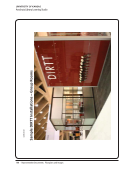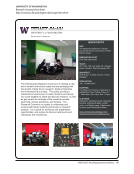212 · Selected Resources: Books and Journal Articles
———. “Does the Building Still Matter? Usage Patterns in New, Expanded, and Renovated Libraries,
1995–2002.” College &Research Libraries 65, no. 2 (2004): 123–50.
Sinclair, Bryan. “Commons 2.0: Library Spaces Designed for Collaborative Learning.” EDUCAUSE Quarterly
30, no. 4 (2007): 4–6.
———. “Evolving Library Space: From “Information Commons” To “Collaborative Learning Commons”.”
Georgia Institute of Technology, http://hdl.handle.net/1853/13614.
Somerville, Mary M. Working Together: Collaborative Information Practices for Organizational Learning. Chicago:
Association of College and Research Libraries, 2009.
Somerville, Mary M., and Navjit Brar. “From Information to Learning Commons: Campus Planning
Highlights.” New Library World 111, no. 5–6 (2010): 179–88.
Somerville, Mary M., Barbara Schader, and Malia E. Huston. “Rethinking What We Do and How We Do It:
Systems Thinking Strategies for Library Leadership.” Australian Academic &Research Libraries 36, no. 4
(2005): 214–27.
Spencer, Mary Ellen. “Evolving a New Model: The Information Commons.” Reference Services Review 34, no. 2
(2006): 242–47.
Staley, David J., Kara J. Malenfant, College Association of, and Libraries Research. Futures Thinking for
Academic Librarians: Higher Education in 2025. Chicago: Association of College &Research Libraries, 2010.
Stanfield, Andrea G., and Russell L. Palmer. “Peer-Ing into the Information Commons: Making the Most of
Student Assistants in New Library Spaces.” Reference Services Review 38, no. 4 (2010): 634–46.
Stark, Megan, and Sue Samson. “Organized Spontaneity: The Learning Commons.” College &Undergraduate
Libraries 17, no. 2/3 (2010): 260–72.
Steiner, H. M., and R. P. Holley. “The Past, Present, and Possibilities of Commons in the Academic Library.”
Reference Librarian 50, no. 4 (2009): 309–32.
Steiner, Sarah K., and M. Leslie Madden. The Desk and Beyond: Next Generation Reference Services. Chicago:
Association of College and Research Libraries, 2008.
Stephens, Michael. “Office Hours: Scanning the Horizon.” Library Journal 136, no. 5 (2011): 86.
Stewart, Christopher. The Academic Library Building in the Digital Age: A Study of Construction, Planning, and
Design of New Library Space. Chicago: Association of College and Research Libraries, 2010.
———. “Half Empty or Half Full? Staffing Trends in Academic Libraries at U.S. Research Universities,
2000–2008.” Journal of Academic Librarianship 36, no. 5 (2010): 394–400.
Stoffle, Carla, and Cheryl Cuillier. “From Surviving to Thriving.” Journal of Library Administration 51, no. 1
(2011): 130–55.
———. “Student-Centered Service and Support: A Case Study of the University of Arizona Libraries’
Information Commons.” Journal of Library Administration 50, no. 2 (2010): 117–34.
———. “Does the Building Still Matter? Usage Patterns in New, Expanded, and Renovated Libraries,
1995–2002.” College &Research Libraries 65, no. 2 (2004): 123–50.
Sinclair, Bryan. “Commons 2.0: Library Spaces Designed for Collaborative Learning.” EDUCAUSE Quarterly
30, no. 4 (2007): 4–6.
———. “Evolving Library Space: From “Information Commons” To “Collaborative Learning Commons”.”
Georgia Institute of Technology, http://hdl.handle.net/1853/13614.
Somerville, Mary M. Working Together: Collaborative Information Practices for Organizational Learning. Chicago:
Association of College and Research Libraries, 2009.
Somerville, Mary M., and Navjit Brar. “From Information to Learning Commons: Campus Planning
Highlights.” New Library World 111, no. 5–6 (2010): 179–88.
Somerville, Mary M., Barbara Schader, and Malia E. Huston. “Rethinking What We Do and How We Do It:
Systems Thinking Strategies for Library Leadership.” Australian Academic &Research Libraries 36, no. 4
(2005): 214–27.
Spencer, Mary Ellen. “Evolving a New Model: The Information Commons.” Reference Services Review 34, no. 2
(2006): 242–47.
Staley, David J., Kara J. Malenfant, College Association of, and Libraries Research. Futures Thinking for
Academic Librarians: Higher Education in 2025. Chicago: Association of College &Research Libraries, 2010.
Stanfield, Andrea G., and Russell L. Palmer. “Peer-Ing into the Information Commons: Making the Most of
Student Assistants in New Library Spaces.” Reference Services Review 38, no. 4 (2010): 634–46.
Stark, Megan, and Sue Samson. “Organized Spontaneity: The Learning Commons.” College &Undergraduate
Libraries 17, no. 2/3 (2010): 260–72.
Steiner, H. M., and R. P. Holley. “The Past, Present, and Possibilities of Commons in the Academic Library.”
Reference Librarian 50, no. 4 (2009): 309–32.
Steiner, Sarah K., and M. Leslie Madden. The Desk and Beyond: Next Generation Reference Services. Chicago:
Association of College and Research Libraries, 2008.
Stephens, Michael. “Office Hours: Scanning the Horizon.” Library Journal 136, no. 5 (2011): 86.
Stewart, Christopher. The Academic Library Building in the Digital Age: A Study of Construction, Planning, and
Design of New Library Space. Chicago: Association of College and Research Libraries, 2010.
———. “Half Empty or Half Full? Staffing Trends in Academic Libraries at U.S. Research Universities,
2000–2008.” Journal of Academic Librarianship 36, no. 5 (2010): 394–400.
Stoffle, Carla, and Cheryl Cuillier. “From Surviving to Thriving.” Journal of Library Administration 51, no. 1
(2011): 130–55.
———. “Student-Centered Service and Support: A Case Study of the University of Arizona Libraries’
Information Commons.” Journal of Library Administration 50, no. 2 (2010): 117–34.






















































































































































































































